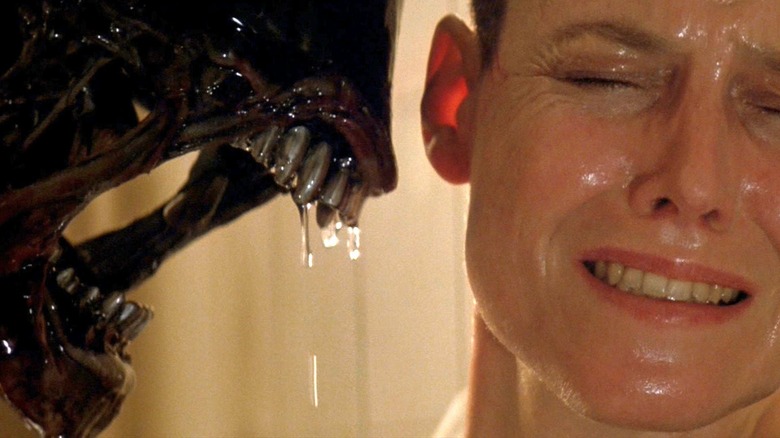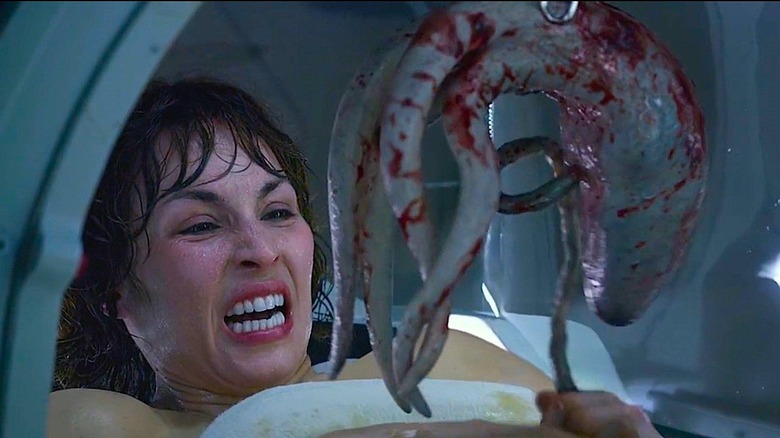Alien: Romulus Finds A New Way To Bring The Franchise's Revolting Sexual Nightmares To Life
This article contains major spoilers for "Alien: Romulus."
The "Alien" franchise has always been for Certified Sickos™, if only because Swiss artist H.R. Giger made sure that every life cycle of the Xenomorph looks as yonic or phallic as possible. No matter how cool the one-liners unloaded in "Aliens" are, how empowered many women feel after watching Ellen Ripley kick ass, or how high people jump out of their seats when a chestburster ... well, chest bursts, this is still a series about folks being terrorized by gooey, crawling vulvas that shove ovipositors down the esophagus and eventually grow into spindly mothers with an engorged meat wand for a head. Giger's penchant for blending fleshy eroticism with black oil-soaked mechanics was not exclusive to the "Alien" films, but they certainly brought his aesthetic into the mainstream — and perhaps most crucially — provided a gateway for the visceral metaphors of sexual assault, forced pregnancy, and the under-discussed potential horrors of childbirth ... applied to more than just cis women.
Xenomorphs reproduce by forcing themselves inside a host, regardless of sex, turning their abdomens into incubators before forcibly ejecting themselves — killing the host body. There's an argument to be made that the "Alien" films are the ultimate pro-abortion stories, as audiences immediately empathize with the hosts being forced to carry something they do not want, never shame the host or act as if they "deserved" to be impregnated, and completely disregard asinine "right to life" debates in favor of hoping the host will make it out alive. Perhaps it's a result of men finally seeing themselves represented in a terrifying birthing scene ... I digress.
"Alien" won the /Film Tournament of Terrors bracket back in 2021 as the greatest horror franchise ever, and it's possible that if the aliens just looked like traditionally slender gray men, "Alien" never would have expanded into the psychosexual nightmare world it became.
Xenopregnancies and endopelvic walls
Because the "Alien" films extend their salacious designs beyond otherworldly creatures, much of the film exists as a double entendre. Veronica Cartwright, who played navigator Joan Lambert in "Alien," spoke about Giger's designs in "Alien Vault: The Definitive Story of the Making of the Film" by Ian Nathan. "His design was so erotic, it was full of vaginas and penises," she said. With moist walls shaping like vaginal canals, even existing in entryways looks suggestive, but the "Alien" films aren't just metaphorically breaking down the horrors of reproduction, they're depicting it firsthand as well. Hell, the program that controls the Weyland-Yutani Corporation ships is called "MU-TH-UR 6000" aka "Mother." When the Synthetics are destroyed they do not bleed blood or even mechanical oil, but a liquid resembling milk — a substance humans create to nourish new life.
When we're first shown the Queen Xenomorph in "Aliens," she's surrounded by eggs, and the sac containing even more of her eggs is nearly the size of her body. This is not presented as the "miracle of life," this is misery. She is essentially a birthing factory with an external womb, refusing to hide the revolting process that brings forth creation. She's also extremely protective of her "babies," not unlike the maternal bond Ellen Ripley creates with the young Newt. When Ripley finds herself as an unwilling surrogate for the Queen in "Alien 3," the visualization of it gestating is presented not dissimilar from a mother observing an ultrasound. Ripley knows that this creature is going to rip her apart in the birthing process, but also knows that if it lives, it will become a scientific specimen. There's no winning here — not for her, and not for her "baby." She instead takes matters into her own hands, terminating her pregnancy and herself at the end of the film.
'Look, it thinks you're its mother.'
"Alien: Resurrection" takes things a step further, with clones of Ripley (still containing Xenomorph DNA) made for the sole purpose of treating the human/alien hybrid like an incubator to house a new Queen Xenomorph. They're able to extract a Queen Alien clone from her, but it has developed a human uterus. No more eggs for the Xenomorph, no, she must give birth the way we do. The result of the birth is the "beautiful baby" Newborn, who rejects its Queen mother and immediately imprints on the Ripley 8 clone. "Look, it thinks you're its mother," the partially cocooned Dr. Jonathan Gediman observes. Ripley 8 is rightfully horrified, but her instinct is to manipulate the creature's trust — weaponizing their bond to lure it into a trap and destroy it. But when her trap of decompression violently sucks the creature through a hole and thrusts it into space, Ripley 8 sheds tears.
This is in stark contrast to the pregnancy in "Prometheus," in which Dr. Elizabeth Shaw essentially performs a self-abortion that resembles a claw machine at the county fair, extracting a tentacled creature directly from her womb via a cesarean section. Upon learning she's pregnant, she's on a mission to remove the creature at all costs. It's established that she's unable to have children early on in the film, addressing her infertility with "I can't create life, what does that say about me?" And yet when she is used to "create" life, she doesn't treat it like a miracle. This is an abomination, and it must die before it has the chance to grow.
Motherhood, pregnancy, and sexual nightmares are well-tread territory in the "Alien" franchise, but "Romulus" takes all of the various approaches to pregnancy and kicks it into high gear.
From the Offspring grows the Xenoman
In "Alien: Romulus," a young explorer named Kay is revealed to be early on in her (human) pregnancy, which complicates things when she is captured by a Xenomorph and seriously injured. The team previously acquired a synthesized strain of black goo (the same as shown in "Prometheus"), believed to help regenerate or create life. Thinking it will help her survive, Kay injects herself with the serum, which essentially speed-runs her pregnancy and mutates her unborn baby's DNA with that of the Xenomorphic goo. This woman, who was previously so excited to become a mother, is now horrified at what she's grown. Her childbirth is painfully gory and she screams to her friend Rain Carradine to get it away from her. Rain rips the umbilical cord with her bare hands and removes the egg/pod she's birthed. As it hatches, the Xenomorph acid blood leaks out of the pod, eating through the floor of the ship but not before revealing a humanoid alien baby hybrid.
Kay begins to lactate the black goo, nourishment the Offspring craves. The creature grows quickly to a gigantic size, boasting male features but a flat vulva on the front of its form. They're a genderless marvel, resembling the Engineers of "Prometheus," but distinctly connected to their mother. They attempt to feed on their mother, but after she rejects them, the Offspring becomes enraged and consumes her instead.
"Alien" films at their core explore themes of creators wanting to destroy that of which they've created and creations looking to obliterate their creator. But in the case of Kay, she was not forcibly impregnated. She was pregnant before she arrived, and she was the one who willingly injected herself with the black goo. And yet, we as the audience still respect her decision to reject her creation, mourning her death when the Offspring kills her for doing so.
It's as if the movie (and the series) is reminding the audience that the decision to terminate should be up to the person carrying the pregnancy regardless of how it got there, and punishing someone for their decision is a tragedy. Here's hoping we won't have to wait for the year 2142 for all of humanity to feel the same.
"Alien: Romulus" is playing in theaters everywhere.



